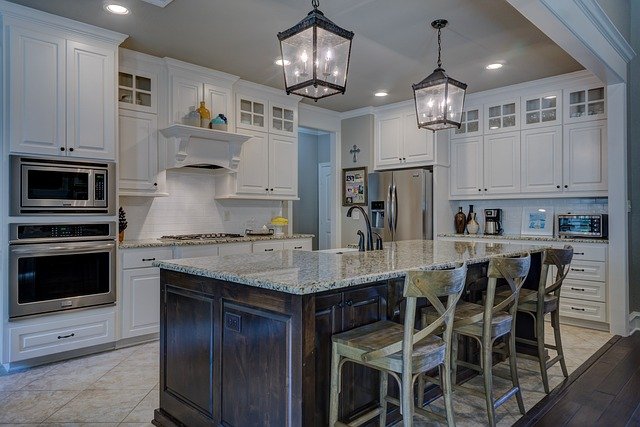Explore kitchen renovation trends and smart solutions for 2025!
Kitchen renovations are an ideal way to transform and upgrade your home. In 2025, more and more homeowners are choosing to invest in kitchen renovations, prioritizing not only aesthetics but also practicality and efficiency. Adopting the latest kitchen design trends, such as open-plan layouts and clever storage solutions, can significantly increase home value. Sustainability is also crucial; environmentally friendly choices and energy-efficient appliances are essential. Explore the endless possibilities of kitchen renovations and make your dream kitchen a reality!

Kitchen remodels in the United States are shifting toward durable finishes, cleaner lines, and technology that quietly improves daily routines. Homeowners are prioritizing practical storage, easy-to-clean surfaces, and energy efficiency, while still seeking warmth and personality. In 2025, expect more induction cooktops, layered lighting, and integrated organization that works for busy households. Thoughtful choices in colors, materials, and layout can boost comfort now and protect resale potential later, whether you hire local services or coordinate a phased DIY approach in your area.
Which kitchen colors can enhance home value?
Neutral, calming palettes remain a safe bet for broad buyer appeal. Warm whites, soft creams, and pale greige create a bright backdrop that pairs well with wood and stone. Muted greens and light blue-grays can add subtle character without overwhelming the space. Two-tone cabinets are popular: lighter uppers keep the room airy, while slightly deeper bases add depth. Consider matte or satin paint finishes to reduce glare and fingerprints, and coordinate hardware in brushed nickel, matte black, or warm brass for a balanced, modern look that supports long-term value.
What mistakes should be avoided in a kitchen renovation?
Common pitfalls include skimping on lighting, underestimating storage, and ignoring ventilation. Relying on a single ceiling fixture leaves shadows; plan task, ambient, and accent layers for even coverage. Drawers often outperform deep base cabinets for daily access. Proper ducted ventilation helps control moisture and cooking odors. Avoid crowding the room with an oversize island; maintain comfortable clearances around all sides. Do not overlook electrical planning for dedicated circuits and outlets along the backsplash and inside islands. Finally, confirm permits, safety devices, and code requirements before work begins.
Mistakes and solutions in kitchen renovation
For layout issues, map clear work zones for prep, cooking, cleaning, and storage; keep a logical path between sink, cooktop, and refrigerator. If counter space is tight, extend work surfaces with a flush-mount induction cooktop and a pull-out cutting board. To solve organization gaps, add full-extension drawers, tray dividers, and vertical pull-outs near the range. Address lighting shortfalls with dimmable under-cabinet LEDs and a brighter 3500–4000 K general layer. Improve indoor air quality with low-VOC paints and sealed composite counters. For budget control, phase upgrades and keep a 10–15 percent contingency for surprises behind walls.
What are 8 key points for a kitchen renovation?
A successful project balances style, function, and durability. Before ordering cabinets or appliances, confirm measurements, door swing clearances, and traffic patterns. Choose resilient finishes for heavy-use zones and confirm maintenance requirements for stone or wood surfaces. When possible, invest in energy-efficient appliances and water-saving fixtures that reduce ongoing costs while supporting comfort.
- Define scope and priorities to prevent scope creep.
- Measure twice, including appliance specs and door swings.
- Plan lighting in layers for task and ambiance.
- Ensure ventilation is ducted and properly sized.
- Choose durable, easy-clean materials and finishes.
- Organize storage with drawers, pull-outs, and dividers.
- Allocate contingency and realistic timelines.
- Confirm permits, safety, and local code compliance in your area.
Which colors make your kitchen look more upscale?
Refined palettes rely on contrast, texture, and restrained accents. Soft black or deep charcoal on an island or lower cabinets can feel elevated when balanced by warm white walls and natural wood. Navy and rich green read polished when paired with brushed brass or muted nickel hardware. Warm neutrals such as mushroom beige and creamy taupe work with quartz or porcelain surfaces that showcase subtle veining. Consider color-blocking for balance: dark bases, lighter uppers, and a mid-tone backsplash. Keep undertones consistent across paint, counters, and flooring to avoid visual clashes that can cheapen the look.
Conclusion Kitchen design in 2025 favors calm colors, ergonomic layouts, smart but discreet technology, and materials that stand up to daily use. By avoiding common mistakes, aligning choices with code and durability, and selecting a timeless palette, you can create a kitchen that performs well today and remains appealing to future buyers in the United States.



